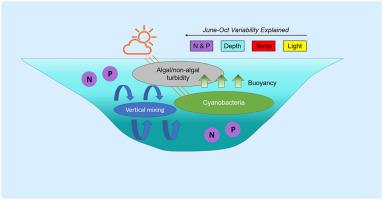Environmental Pollution ( IF 8.9 ) Pub Date : 2020-12-04 , DOI: 10.1016/j.envpol.2020.116210 Yue Han , Tarek N. Aziz , Dario Del Giudice , Nathan S. Hall , Daniel R. Obenour

|
Harmful algal blooms are increasingly recognized as a threat to the integrity of freshwater reservoirs, which serve as water supplies, wildlife habitats, and recreational attractions. While algal growth and accumulation is controlled by many environmental factors, the relative importance of these factors is unclear, particularly for turbid eutrophic systems. Here we develop and compare two models that test the relative importance of vertical mixing, light, and nutrients for explaining chlorophyll-a variability in shallow (2–3 m) embayments of a eutrophic reservoir, Jordan Lake, North Carolina. One is a multiple linear regression (statistical) model and the other is a process-based (mechanistic) model. Both models are calibrated using a 15-year data record of chlorophyll-a concentration (2003–2018) for the seasonal period of cyanobacteria dominance (June–October). The mechanistic model includes a novel representation of vertical mixing and is calibrated in a Bayesian framework, which allows for data-driven inference of important process rates. Both models show that chlorophyll-a concentration is much more responsive to nutrient variability than mixing, light, or temperature. While both models explain approximately 60% of the variability in chlorophyll-a, the mechanistic model is more robust in cross-validation and provides a more comprehensive assessment of algal drivers. Overall, these models indicate that nutrient reductions, rather than changes in mixing or background turbidity, are critical to controlling cyanobacteria in a shallow eutrophic freshwater system.
中文翻译:

探索浅浊水库藻类生产的养分和光限
有害的藻华日益被人们视为对淡水水库完整性的威胁,淡水水库可作为水源,野生动植物栖息地和休闲胜地。尽管藻类的生长和积累受许多环境因素控制,但这些因素的相对重要性尚不清楚,尤其是对于混浊的富营养化系统而言。在这里,我们开发和比较了两个模型,这些模型测试了垂直混合,光和养分对解释叶绿素的相对重要性,该叶绿素是北卡罗来纳州约旦湖富营养化水库浅层(2-3 m)隔离层中的变异性。一种是多元线性回归(统计)模型,另一种是基于过程的(机械)模型。两种模型均使用15年的叶绿素a数据记录进行了校准蓝细菌优势季节(6月至10月)的浓度(2003-2018年)。该机理模型包括垂直混合的新颖表示,并在贝叶斯框架中进行了校准,从而允许以数据为依据的重要过程速率推断。两种模型都表明,叶绿素的浓度比混合,光照或温度对养分变异性的响应要强得多。虽然这两种模型都能解释约60%的叶绿素a变异性,该机制模型在交叉验证中更强大,并且可以对藻类驱动程序进行更全面的评估。总体而言,这些模型表明,减少浅层富营养化淡水系统中的蓝细菌对减少营养素,而不是减少混合比或背景混浊的变化至关重要。


























 京公网安备 11010802027423号
京公网安备 11010802027423号